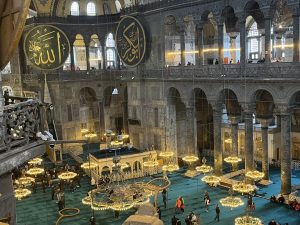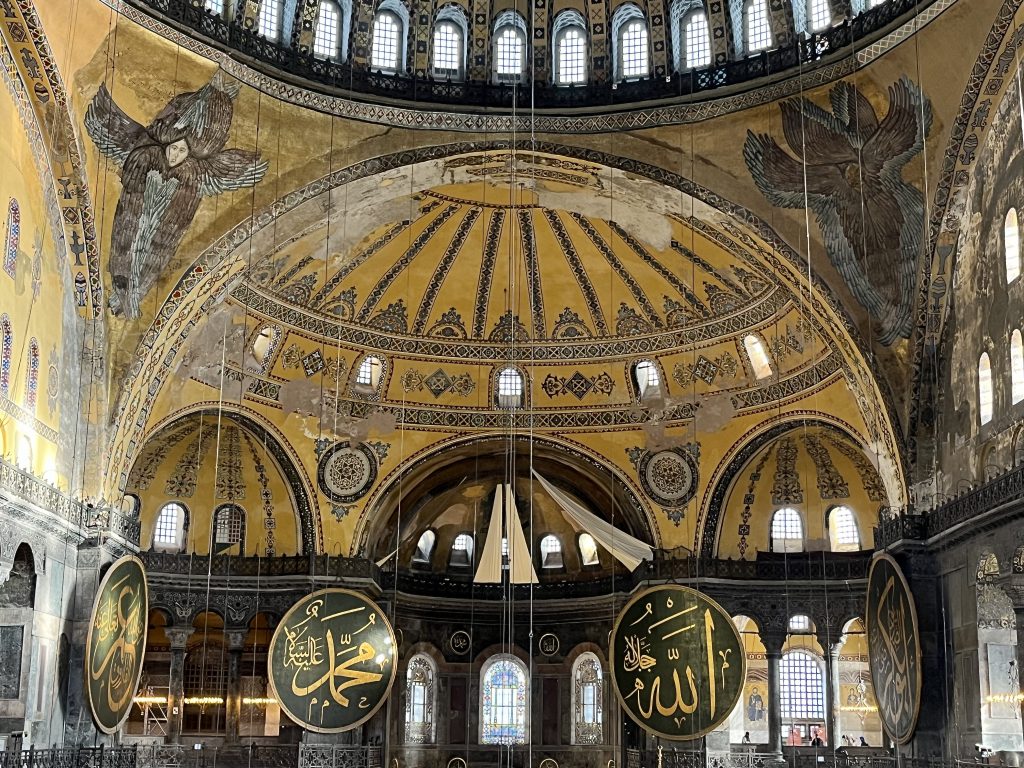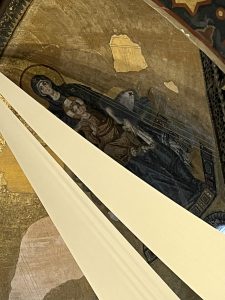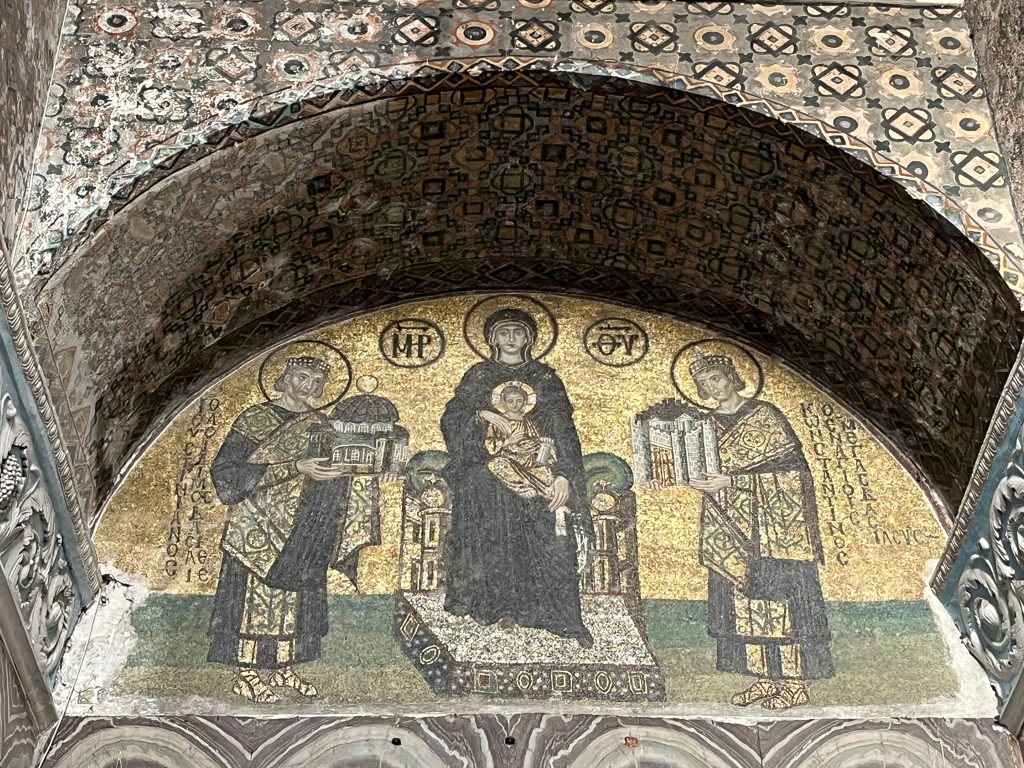 Admission (gallery only): 25 euros; children under 3 free, under 8s 12.5 euros; no other discounts for Turks, students, the elderly, museum cards. No disabled access to gallery. Women must cover their hair.
Admission (gallery only): 25 euros; children under 3 free, under 8s 12.5 euros; no other discounts for Turks, students, the elderly, museum cards. No disabled access to gallery. Women must cover their hair.
Right at the heart of the historic peninsula of İstanbul (the old Constantinople), Hagia Sophia, now the Ayasofya Cami, started life as a huge church, commissioned by the Emperor Justinian on the site of two older versions in 532. The work took almost six years to complete whereupon it became the biggest church in Christendom. The architects were Isidore of Miletus and Anthemius of Tralles who should by rights be as famous as Sinan. Unfortunately they miscalculated the ability of their dome to stand up to an earthquake and in 558 it collapsed. It was redesigned by Isidore’s nephew whose dome has stood the test of the ensuing 1,500-odd years.
Much evidence of the original purpose of the building still remains. A wonderful square of opus sectile pavement in the prayer hall marks the spot where the Byzantine emperors were crowned. Panels of marble ringing the gallery are still marred by marks showing where the arms of crosses were scraped off them. Most of all there are the mosaics, the enormous one of the Virgin Mary and the infant Jesus, now partially concealed by drapes in the apse, but most of them in the gallery which is open to visitors as a museum.
In 1453, having broken through the Land Walls protecting Constantinople, Sultan Mehmed the Conqueror (Fatih Sultan Mehmed) rode into the church to claim it for Islam. It served as a mosque from then until 1934 when Atatürk turned it into a museum. The evidence of the conversion is plain to see in the four minarets (two of them by Sinan) and the mihrab added to the church. Additionally, many of the sultans made further changes to the building, adding a library, a sultans’s box, a time-keeper’s lodge and their own tombs.
In 2020 the museum was closed and the ancient church reopened as Ayasofya Cami, hugely increasing the congestion as worshippers joined tourists in the prayer hall. Perhaps inevitably in 2024 the gallery was reopened as a museum and tourists were barred from the prayer hall with the exception of foreign Muslims who can enter at prayer times and non-Muslim Turks who can go in in between prayer times on production of their kimliks (ID cards). It remains to be seen whether the gallery will be able to cope with the number of tourists wanting to visit in high season.

Inside the prayer hall
For most visitors it will now only be possible to view the prayer hall from the gallery.
Hagia Sophia was originally entered via a double narthex, with the inner narthex far more elaborate than the outer. The emperor would have entered via the Orea Porta or Beautiful Gate and proceeded to the Imperial Gate, its threshold deeply indented by all the feet that have crossed it. Above it is a mosaic showing Emperor Leo the Wise (r. 886-912) prostrating himself before Christ. This doorway is one of nine leading from the inner narthex that probably date back to the reign of Justinian. Nowadays the narthex is lined with boxes where worshippers can leave their shoes.
Inside the prayer hall to the left and right stand two giant alabaster urns dating back to Hellenistic times and brought here from Bergama. Further to the left visitors used to be able to rotate their fingers in the so-called Weeping Column (officially, the column of St Gregory the Miracle Worker) in the hope of a cure for eye ailments or a boost to their fertility. It was a practise apparently dating back to the 13th century that is no longer permitted.
To the right in a square cut out of the turquoise carpet that now covers the old flagstoned floor is the opus sectile Omphalos where the emperors used to be crowned.
Deeper into the prayer hall evidence of the original conversion of the church into a mosque is obvious in the form of the mihrab, the mimber and the platforms for the muezzins to lead Friday prayers. Off to the right there’s also a small library added by Sultan Mahmud I in 1739. In the 1840s Sultan Abdülmecid I also added a box where the sultan could pray close to the mihrab but with his privacy maintained by screens. It was at this time that the great wooden roundels bearing the names of the first Islamic leaders were hung in the mosque.
A mosaic of the Virgin Mary bestrides the apse on a glorious golden background. It dates from 867 and was the first figurative mosaic to be added to the church after the end of the Iconoclastic period when Christianity was just as prohibitive of human imagery in religious buildings as Islam is today. Since 2020 it has been shrouded with curtains so that worshippers don’t have to look at it although it can still be glimpsed side on from the gallery.
The dome would once have featured a magnificent mosaic Pantocrator scene of the type still to be seen in the Fethiye Cami museum in Karagümrük. Its place has now been taken by a verse from the Koran. The pendentives are decorated with seraphim, one of whose mosaic faces was revealed during restoration in 2009.
The gallery
For most visitors this is the only part of Ayasofya that they will be able to visit. The most important things to see up here are the mosaics created over a period stretching from the 10th to the 13th centuries.
The oldest mosaic is a relatively small and easily overlooked 10th-century image of the Emperor Alexandros (r.912-13). At the furthest point of the gallery two more mosaics sit on either side of a window. The one on the left shows Christ blessing Emperor Constantine IX Monomachos (r.1042-55) and his wife, Zoe, whose face has been altered three times as she married and married again. The one on the right shows Mary with Jesus in between the Emperor John II Komnenos (r. 1118-43) and his wife, Eirene, with their son, Alexios, on the adjacent wall – the latter panel was added in 1122 when he became co-emperor with his father.
A much bigger but more damaged panel shows the Deesis with Christ in between Mary and St John the Baptist. It is a work of the Byzantine Revival movement that flowered after the Latins were kicked out of the city in 1261. The faces of the three figures are far less rigid, far more full of life and personality than those of the earlier mosaics.

Also in the gallery you should look out for a signature carved into the balustrade by Halvdan, a Viking visitor to the city in the 9th-century. Of passing interest, too, is the 13th-century “gravestone” of Enrico Dandalo (1107-1205), the Doge of Venice who led the Crusaders in sacking Constantinople in 1204 when he was not only 98 but also apparently completely blind. His bones were supposedly thrown to the dogs; the gravestone is a cenotaph memorial installed in the 19th century.
The part of the gallery with the mosaics in it is accessed via the so-called Gates of Heaven and Hell, 6th-century slabs of marble carved in the shape of doors right down to the imitation doorhandles and locks. They are thought to have screened off the part of the gallery that was the private domain of the emperor.
The stairs to the exit bring you out in the Vestibule of the Warriors where the emperor’s bodyguard waited while he prayed. The bronze Splendid Door leading from it into the narthex (now closed) once adorned a 2nd-century temple in Tarsus. It was bequeathed to the church by the Emperor Theophilus (r. 829-42). Above it is a 10th-century mosaic depicting the Virgin Mary with Jesus in between Constantine who is presenting her with a model of the city and Justinian who is presenting a moderl of Hagia Sophia.

The külliye (mosque complex)
Mektep sibyan To the right of the entrance for worshippers is a small domed building that was an early 18th-century primary school.
Muvakkithane Precise time-keeping is essential in Islam for ensuring the correct prayer times throughout the year. It is also especially important during Ramazan for indicating the time of iftar and the end of the fasting day. This small domed structure was built by the Swiss Fossatti brothers who carried out an extensive restoration of Ayasofya in the 1850s.
Tombs of the Sultans Sultans Selim II, Murad III, Mehmed III, and Mustafa I are buried in the grounds of Ayasofya rather than in purpose-built complexes of their own. When Sultan Mustafa I died of typhus after a second brief and unhappy reign as sultan following the assassination of Osman II, he was buried inside the old baptistry of Hagia Sophia. Beside him was laid to rest Sultan İbrahim, known as “the Mad”. Briefly open to the public, in 2024 they were again under restoration.
İmaret The imaret (soup kitchen) on the corner opposite the entrance to Topkapı Sarayı was briefly open to the public as an excellent Carpet Museum but has not reopened since Covid. Behind it but never open to the public was the Skeuophlakion which served as the treasury for the emperors.
Transport info
Ayasofya Cami will be within easy walking distance of many visitors’ hotels. If you’re travelling from elsewhere in the city the easiest access is likely to be via the Sultanahmet tram stop.
What to see nearby
Ayasofya Tarihi Müzesi (History Museum)
Haseki Hürrem Hamamı
Museum of Turkish and Islamic Arts



